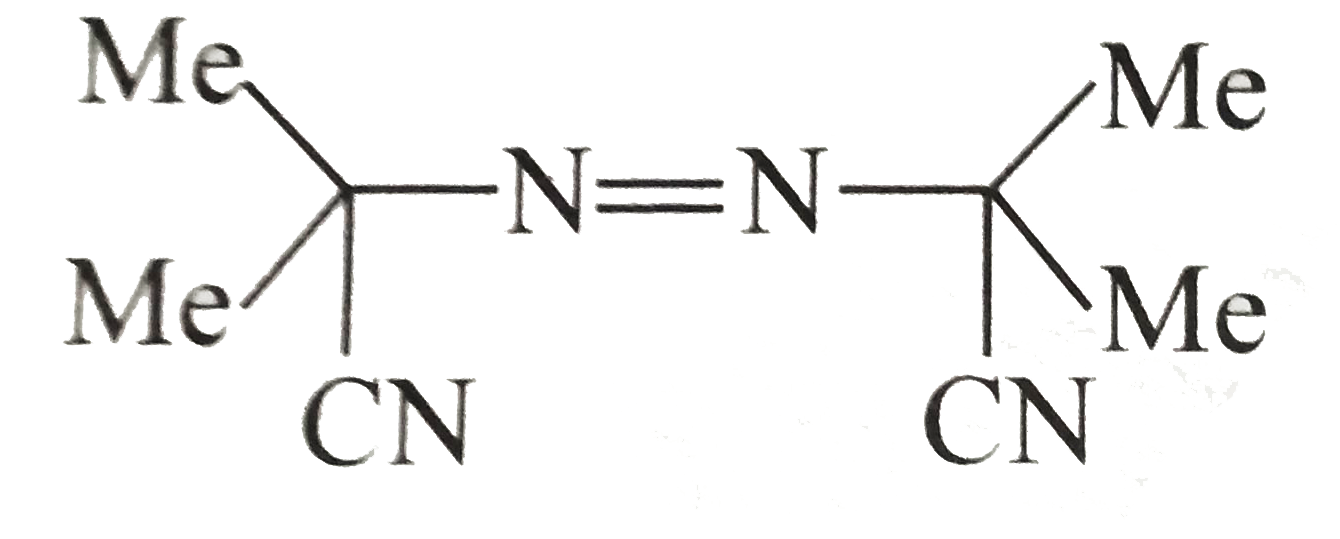When a mixture of 2-merthyl propane and CC14 is reacted at 403-413 in the presence of a radical intiator, t-butyl peroxide, 2-chloro-2-methyl propane and chloroform (CHC13 are formed. Give the mechanism of the reaction.
To understand the mechanism of the reaction between 2-methylpropane and carbon tetrachloride (CCl4) in the presence of a radical initiator, we can break it down into several steps: initiation, propagation, and termination.
Step 1: Chain Initiation
1. Formation of Radicals: The reaction begins with the thermal decomposition of the radical initiator, t-butyl peroxide (C4H10O2). When heated (or exposed to light), t-butyl peroxide undergoes homolytic cleavage, breaking the O-O bond to form two t-butyl radicals:
(CH3)3COO-heat/light−−−−−−→(CH3)3C⋅+(CH3)3C⋅
Step 2: Chain Propagation
2. Hydrogen Abstraction: The t-butyl radical can then react with 2-methylpropane (C5H12). It abstracts a hydrogen atom from 2-methylpropane, forming 2-methylpropyl radical and generating isobutane (C4H10):
(CH3)3C⋅+C5H12→(CH3)2C⋅(C2H5)+H2
3. Formation of Chloro Compounds: The 2-methylpropyl radical can then react with carbon tetrachloride (CCl4). The radical abstracts a chlorine atom from CCl4, forming 2-chloro-2-methylpropane and generating a CCl3 radical:
(CH3)2C⋅+CCl4→(CH3)2CCl+CCl⋅3
4. Formation of Chloroform: The CCl3 radical can then react with another molecule of 2-methylpropane, abstracting another hydrogen atom to form chloroform (CHCl3) and regenerating the 2-methylpropyl radical:
CCl⋅3+C5H12→CHCl3+(CH3)2C⋅
Step 3: Chain Termination
5. Termination: The reaction can terminate when two radicals combine to form a stable product. However, in this case, the continuous generation of radicals allows the reaction to proceed.
Summary of Products
- The main products of the reaction are 2-chloro-2-methylpropane and chloroform (CHCl3).
1. Formation of Radicals: The reaction begins with the thermal decomposition of the radical initiator, t-butyl peroxide (C4H10O2). When heated (or exposed to light), t-butyl peroxide undergoes homolytic cleavage, breaking the O-O bond to form two t-butyl radicals:
(CH3)3COO-heat/light−−−−−−→(CH3)3C⋅+(CH3)3C⋅
2. Hydrogen Abstraction: The t-butyl radical can then react with 2-methylpropane (C5H12). It abstracts a hydrogen atom from 2-methylpropane, forming 2-methylpropyl radical and generating isobutane (C4H10):
(CH3)3C⋅+C5H12→(CH3)2C⋅(C2H5)+H2
(CH3)2C⋅+CCl4→(CH3)2CCl+CCl⋅3
CCl⋅3+C5H12→CHCl3+(CH3)2C⋅
5. Termination: The reaction can terminate when two radicals combine to form a stable product. However, in this case, the continuous generation of radicals allows the reaction to proceed.
- The main products of the reaction are 2-chloro-2-methylpropane and chloroform (CHCl3).
Topper's Solved these Questions
- ALKANES AND CYCLOALKANESBook:CENGAGE CHEMISTRY ENGLISHChapter:ALKANES AND CYCLOALKANESExercise:Paragraph for problem
Explore 24 Videos
- ALKANES AND CYCLOALKANESBook:CENGAGE CHEMISTRY ENGLISHChapter:ALKANES AND CYCLOALKANESExercise:True and False
Explore 1 Video
- ALKANES AND CYCLOALKANESBook:CENGAGE CHEMISTRY ENGLISHChapter:ALKANES AND CYCLOALKANESExercise:SOLVED EXAMPLES
Explore 19 Videos
- ALKENES AND ALKADIENESBook:CENGAGE CHEMISTRY ENGLISHChapter:ALKENES AND ALKADIENESExercise:Single correct Answer
Explore 14 Videos
Similar Questions
An alkyl halide is reduced to the corresponding alkane by tributyl stannane (C4H9)3SnH and by a free radical menchanism in the presence of an initiator, an azo compound

that breaks down to N2 and a radical. Give the mechanism of the reaction.
View SolutionIdentify the product formed when propan-I ol is treated with Conc. H2SO4 at 413 K. Write the mechanism involved for the above reaction.
View Solution
Knowledge Check
Assertion: Addition of HBr to propene yields 2-bromopropane but in presence of a peroxide it yields 1-bromopropane.
Reason: When reaction is carried out in the presence of a peroxide it follows free radical mechanism, 2∘ free radical is more stable than 1∘ free radical.AIf both assertion and reson are true and reason is the correct explanation of assertionBIf both assertion and reason are true but reason is not the correct explanation of assertion.CIf assertion is true but reason is false.DIf both assertion and reason are false.3-methyl-pent-2-ene on reaction with HBr in the presence of peroxide forms an addition product. The number of possible stereoisomers for the product is
AtwoBfourCsixDzero
What happens when propan-1-ol is treated with ethanoic acid in the presence of concentrated H2SO4?
View SolutionOxidation of 2-methyl propane-1,2-diol with periodic acid gives:-
View SolutionThe coupling betweenC2H5MgBr and MeBr gives propane in the presence of :
View SolutionState whether each of the following is true or false.
a. Photobromination of 2-methylpropane gives a mixture of 1-bromo-2-methylpropane gives a mixture of 1-bromo-2-methylpropane and 2-bromo-2-methylpropa ne in the ratio 9:1
b. The percentage of n-propyl chloride obtained in the chlorination of propane is about 56%.
c. The percentage of 1-chloro-2-methylpropane obtained in the chlorination of isobutane is about 64%.
d. The percentage of n-propyl bromide in the bromination of propane is 44% . The relative reactives of 3∘ , 2∘ and 1∘ H atoms are 1600:82:1 .
View SolutionAddition of HBr to propene yields 2-bromopropane, while in the presence of benzoyl peroxide, the same reaction yields 1-bromopropane. Explain and give mechanism.
View SolutionIt we see the reaction of methane with halogen, the rate determining step for chlorination is, endothermic reaction of the chlorine atom with methane to form methyl radical and a molecule of HCl. So free radical is the intermediate of the reaction. Formation of free radical depends upon the energy required to break a bond between a hydrogen atom and a carbon atom. Chlorination of propane and Bromination of propane. when compared it is found that bromination is more selective than chlorination. The probability factor for 3∘,2∘,1∘H atom is 5.0:3.8:1.0 at 25∘C for chlorination.
Isobutane when reacts with chlorine in presence of ultra violet radiations yield 2 products primary hydrogen substituted and 3∘ hydrogen substituted Find their % in product mixture
View Solution
